最新小学英语课题立项申请(B表)
- 格式:doc
- 大小:46.50 KB
- 文档页数:7
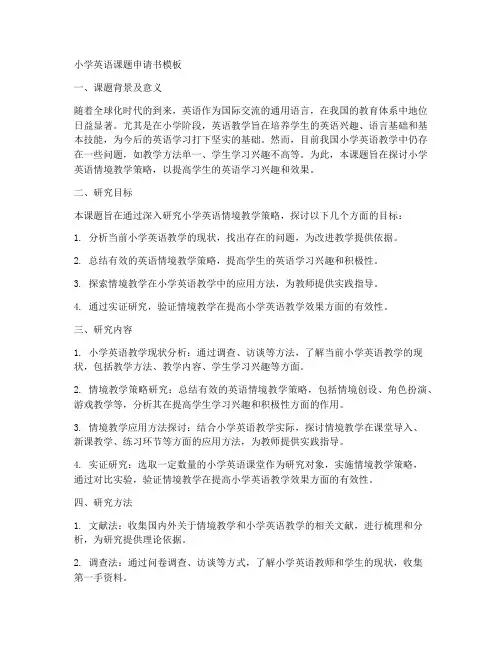
小学英语课题申请书模板一、课题背景及意义随着全球化时代的到来,英语作为国际交流的通用语言,在我国的教育体系中地位日益显著。
尤其是在小学阶段,英语教学旨在培养学生的英语兴趣、语言基础和基本技能,为今后的英语学习打下坚实的基础。
然而,目前我国小学英语教学中仍存在一些问题,如教学方法单一、学生学习兴趣不高等。
为此,本课题旨在探讨小学英语情境教学策略,以提高学生的英语学习兴趣和效果。
二、研究目标本课题旨在通过深入研究小学英语情境教学策略,探讨以下几个方面的目标:1. 分析当前小学英语教学的现状,找出存在的问题,为改进教学提供依据。
2. 总结有效的英语情境教学策略,提高学生的英语学习兴趣和积极性。
3. 探索情境教学在小学英语教学中的应用方法,为教师提供实践指导。
4. 通过实证研究,验证情境教学在提高小学英语教学效果方面的有效性。
三、研究内容1. 小学英语教学现状分析:通过调查、访谈等方法,了解当前小学英语教学的现状,包括教学方法、教学内容、学生学习兴趣等方面。
2. 情境教学策略研究:总结有效的英语情境教学策略,包括情境创设、角色扮演、游戏教学等,分析其在提高学生学习兴趣和积极性方面的作用。
3. 情境教学应用方法探讨:结合小学英语教学实际,探讨情境教学在课堂导入、新课教学、练习环节等方面的应用方法,为教师提供实践指导。
4. 实证研究:选取一定数量的小学英语课堂作为研究对象,实施情境教学策略,通过对比实验,验证情境教学在提高小学英语教学效果方面的有效性。
四、研究方法1. 文献法:收集国内外关于情境教学和小学英语教学的相关文献,进行梳理和分析,为研究提供理论依据。
2. 调查法:通过问卷调查、访谈等方式,了解小学英语教师和学生的现状,收集第一手资料。
3. 实证研究法:在实际教学中运用情境教学策略,通过对比实验,观察和记录学生的学习情况,分析情境教学的效果。
4. 案例分析法:挑选具有代表性的小学英语情境教学案例,进行深入剖析,总结经验教训。
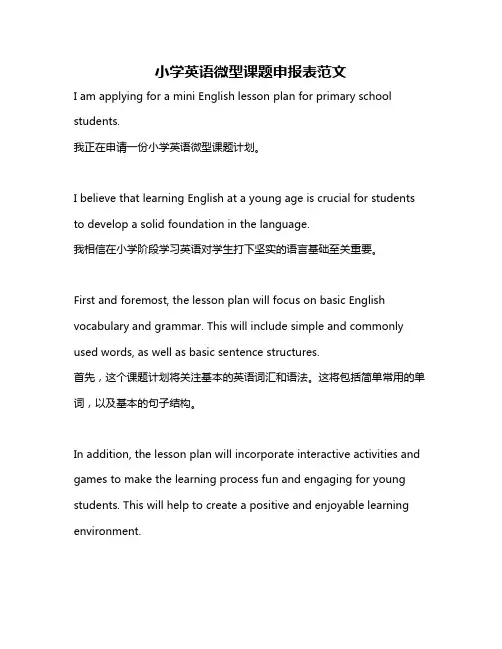
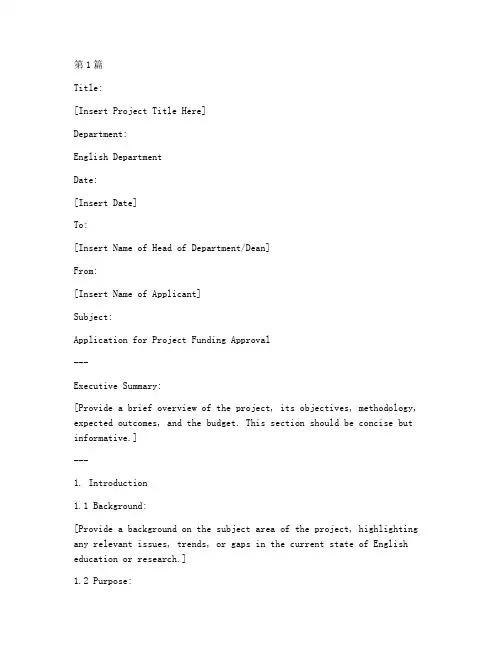
第1篇Title:[Insert Project Title Here]Department:English DepartmentDate:[Insert Date]To:[Insert Name of Head of Department/Dean]From:[Insert Name of Applicant]Subject:Application for Project Funding Approval---Executive Summary:[Provide a brief overview of the project, its objectives, methodology, expected outcomes, and the budget. This section should be concise but informative.]---1. Introduction1.1 Background:[Provide a background on the subject area of the project, highlighting any relevant issues, trends, or gaps in the current state of English education or research.]1.2 Purpose:[Explain the purpose of the project, including its intended outcomes and how it will contribute to the field of English studies.]1.3 Objectives:[Outline the specific objectives of the project, detailing what is to be achieved.]---2. Project Description2.1 Project Overview:[Provide a detailed description of the project, including its scope, activities, and the timeline for completion.]2.2 Project Activities:[Describe the specific activities that will be carried out to achieve the project objectives. Include any workshops, seminars, research, curriculum development, or other relevant activities.]2.3 Project Methodology:[Explain the methodology that will be used to carry out the project activities. This may include qualitative or quantitative research methods, data collection techniques, and analysis procedures.]2.4 Project Timeline:[Provide a timeline for the project, including key milestones and deadlines.]---3. Expected Outcomes3.1 Academic Outcomes:[Discuss the expected academic outcomes of the project, such as new research findings, improved teaching methods, or the development of new educational resources.]3.2 Professional Development:[Explain how the project will contribute to the professional development of faculty and students involved, including any workshops, training sessions, or mentorship opportunities.]3.3 Community Impact:[Describe how the project will impact the local community or the broader public, including any public outreach activities or engagement withlocal schools, libraries, or cultural organizations.]---4. Budget4.1 Funding Request:[Provide a detailed budget, outlining the total amount of funding requested and how it will be allocated.]4.2 Budget Allocation:[Break down the budget into specific categories, such as personnel, materials, travel, equipment, and other expenses.]4.3 Justification:[Justify each budget item, explaining why it is necessary for the successful completion of the project.]---5. Implementation Plan5.1 Staff Involvement:[Identify the key personnel involved in the project, including their roles and responsibilities.]5.2 Resource Allocation:[Discuss how resources, such as facilities, equipment, and materials, will be allocated and managed.]5.3 Risk Management:[Identify potential risks associated with the project and outline strategies for mitigating these risks.]---6. Evaluation Plan6.1 Evaluation Criteria:[Define the criteria that will be used to evaluate the success of the project.]6.2 Evaluation Methods:[Outline the methods that will be used to evaluate the project, such as surveys, interviews, focus groups, or data analysis.]6.3 Dissemination of Results:[Explain how the results of the project will be disseminated to the wider academic community and the public.]---7. References[Include a list of references to any literature or research that supports the project.]---8. Appendices[Include any additional materials that support the project proposal, such as letters of support, resumes of key personnel, or detailed budget breakdowns.]---9. Conclusion[Summarize the key points of the project proposal and reiterate the importance and potential impact of the project.]---10. Signature Page[Include a signature page for the applicant and any relevant departmental or institutional officials to sign and approve the proposal.]---Note:This template is designed to be a comprehensive guide for drafting an English discipline project proposal. It is important to tailor the content to the specific project and institution. The length of the proposal may vary depending on the complexity and scope of the project.第2篇---Title of the Project:[Insert Project Title Here]Project Proposal Prepared By:[Your Name][Your Position][Your Department][Your Institution]Date of Submission:[Date]---Table of Contents1. Introduction2. Project Background3. Objectives and Rationale4. Project Description4.1 Project Overview4.2 Target Audience4.3 Project Duration4.4 Expected Outcomes5. Project Methodology5.1 Research Methodology5.2 Teaching and Learning Strategies5.3 Evaluation and Assessment Methods6. Project Implementation Plan6.1 Timeline6.2 Key Activities6.3 Resources Required7. Budget and Financial Plan7.1 Project Budget7.2 Funding Sources8. Project Management and Coordination 8.1 Project Management Structure8.2 Responsibilities of Key Personnel8.3 Risk Management9. Expected Impact and Sustainability10. References---1. IntroductionThe following document outlines the proposal for a new English discipline project aimed at enhancing the teaching and learning of English language and literature within [Your Institution]. This project is designed to address the current needs and challenges faced by students and faculty in the English department, with the ultimate goal of improving the overall quality of education and fostering a deeper appreciation for the English language and its rich cultural heritage.2. Project Background[Provide a brief background of the English department, highlighting any existing strengths, challenges, or gaps in the curriculum and teaching methods. Include information on the current student population, faculty composition, and any relevant data or research findings.]3. Objectives and RationaleThe primary objectives of this project are as follows:- To enhance the proficiency of students in English language skills (reading, writing, speaking, and listening).- To deepen students' understanding and appreciation of English literature and cultural studies.- To integrate technology and innovative teaching methods into the English curriculum.- To provide professional development opportunities for faculty members in the field of English language and literature.- To foster a collaborative and inclusive learning environment that encourages critical thinking and cultural awareness.The rationale for this project is based on the following points:- The increasing importance of English as a global language in the context of internationalization and global communication.- The need for a more dynamic and engaging curriculum that caters to the diverse needs and interests of students.- The importance of equipping students with the necessary skills to succeed in their academic and professional endeavors.- The opportunity to leverage technology and innovative teaching methods to enhance the learning experience.4. Project Description4.1 Project OverviewThis project will involve a comprehensive approach to the teaching and learning of English, including curriculum development, faculty training, student engagement activities, and the integration of technology. The project will be implemented in phases over a period of [Insert Duration, e.g., three years].4.2 Target AudienceThe target audience for this project includes:- Undergraduate and postgraduate students enrolled in English language and literature programs.- Faculty members teaching English language and literature courses.- Administrators and staff involved in the management and support of the English department.4.3 Project DurationThe project is expected to run for [Insert Duration, e.g., three years], with specific milestones and deliverables outlined in the implementation plan.4.4 Expected OutcomesThe expected outcomes of this project include:- Improved language proficiency and critical thinking skills among students.- Enhanced teaching and learning experiences through the integration of innovative methods and technologies.- Increased student engagement and satisfaction with the English curriculum.- Enhanced professional development opportunities for faculty members.- A more inclusive and culturally diverse learning environment.5. Project Methodology5.1 Research MethodologyThe project will employ both qualitative and quantitative research methods to assess the impact of the project on students and faculty. This will include surveys, interviews, focus groups, and data analysis of student performance.5.2 Teaching and Learning StrategiesThe project will utilize a variety of teaching and learning strategies, including:- Project-based learning- Flipped classrooms- Gamification- Collaborative learning- Technology integration (e.g., online learning platforms, educational apps)5.3 Evaluation and Assessment MethodsThe project will employ a range of evaluation and assessment methods, including:- Formative and summative assessments- Self-assessment and peer-assessment- Portfolios- Standardized tests6. Project Implementation Plan6.1 Timeline[Provide a detailed timeline with key milestones, including dates for the completion of various phases of the project.]6.2 Key Activities- Curriculum review and development- Faculty training workshops- Student engagement activities- Technology integration- Project assessment and evaluation6.3 Resources RequiredThe project will require the following resources:- Human resources (faculty, staff, students)- Financial resources (for training, materials, technology)- Physical resources (classrooms, equipment, technology infrastructure)7. Budget and Financial Plan7.1 Project Budget[Provide a detailed budget outlining the expected costs of the project, including personnel, materials, technology, and other expenses.]7.2 Funding Sources[Identify potential funding sources, such as grants, institutional funding, and external partnerships.]8. Project Management and Coordination8.1 Project Management StructureThe project will be managed by a steering committee composed of key stakeholders from the English department and other relevant departments.8.2 Responsibilities of Key Personnel[Define the roles and responsibilities of key personnel involved in the project.]8.3 Risk ManagementThe project will identify and mitigate potential risks through a risk management plan.9. Expected Impact and SustainabilityThe expected impact of this project is to significantly improve the quality of English education at [Your Institution]. The project is designed to be sustainable by ensuring that the new practices and resources developed during the project are integrated into the ongoing curriculum and teaching practices.10. References[Include a list of references cited in the proposal.]---ConclusionThis project proposal outlines a comprehensive plan to enhance the teaching and learning of English language and literature at [Your Institution]. By addressing the needs of students and faculty, integrating technology and innovative methods, and fostering a collaborative learning environment, this project aims to make a lasting and positive impact on the English discipline at [Your Institution].We believe that this project has the potential to significantly improve the quality of education and prepare students for success in their future academic and professional lives. We kindly request your support and approval for the implementation of this project.第3篇Project Title:[Insert Project Title Here]Project Summary:[Provide a brief overview of the project, including its objectives, target audience, and expected outcomes.]I. IntroductionA. Background Information[Provide a detailed background on the topic of the project, including any relevant statistics, trends, or challenges in the field of English education.]B. Purpose of the Project[Explain the main purpose of the project and how it aligns with the goals of the English department and the institution.]C. Project Objectives[List specific, measurable objectives that the project aims to achieve.]II. Project DescriptionA. Project Scope[Define the scope of the project, including the specific activities, time frame, and resources required.]B. Project Activities[Detail the activities that will be carried out to achieve the project objectives. Include the following sections:1. Research and Development:- Description of the research methodology to be used.- Outline of the literature review process.- Details of any pilot studies or feasibility assessments.2. Curriculum Development:- Description of the new or revised curriculum to be developed.- Justification for the curriculum changes.- Strategies for implementing the new curriculum.3. Training and Professional Development:- Description of the training programs for faculty and staff.- Details of the content and delivery methods of the training.- Evaluation methods for the effectiveness of the training.4. Technology Integration:- Description of the technology tools and platforms to be used.- Justification for the chosen technology.- Training for faculty and students on the use of technology.5. Community Engagement:- Description of the community outreach activities.- Target audience for the outreach.- Expected outcomes of the community engagement.6. Assessment and Evaluation:- Description of the assessment methods to be used.- Criteria for evaluating the project’s success.- Timeline for assessments and evaluation reports.C. Project Timeline[Provide a detailed timeline for the project, including key milestones and deadlines.]III. Project BudgetA. Budget Overview[Present a comprehensive budget for the project, including all anticipated expenses and revenues.]B. Budget Breakdown[Break down the budget into specific categories, such as personnel, materials, technology, travel, and contingency funds.]C. Funding Sources[Identify potential funding sources, including institutional support, grants, and external sponsorships.]IV. Project TeamA. Principal Investigator[Provide a brief biography of the principal investigator, highlighting relevant qualifications and experience.]B. Co-Investigators and Collaborators[List the names and qualifications of any co-investigators or collaborators involved in the project.]C. Project Staff[Describe the roles and responsibilities of the project staff, including any new positions that may be created.]V. Project Risks and Mitigation StrategiesA. Identification of Risks[Identify potential risks that could impact the project’s success.]B. Mitigation Strategies[Outline strategies to mitigate these risks and ensure the project’s continuity.]VI. ConclusionA. Project Significance[Summarize the significance of the project and its potential impact on English education and the institution.]B. Call to Action[Encourage the review committee to support the project and provide the necessary resources for its implementation.]VII. Appendices[Include any additional materials that support the project proposal, such as letters of support, detailed budgets, and research findings.]---Note: This template is a guide and should be customized to fit the specific requirements and context of the project being proposed. The word count of 2500 words is an estimate and can vary depending on the level of detail provided in each section.。

Title: English Education Initiative ProposalIntroduction:The purpose of this proposal is to outline a comprehensive English education initiative that aims to improve the language proficiency and communication skills of students in our community. This initiative will provide students with high-quality English language instruction, resources, and opportunities for practice, enabling them to achievetheir academic and personal goals.1. Project Objectives:The primary objectives of this English education initiative are as follows:- To enhance the English language proficiency of students in our community.- To improve students' ability to communicate effectively in English, both orally and in writing.- To provide students with opportunities to practice English in real-life scenarios.- To create a supportive and engaging learning environment that encourages students to develop a love for the English language.2. Target Audience:The target audience for this initiative will be students in grades 6-12, as well as adults who are seeking to improve their English language skills. The initiative will be implemented in schools, community centers, and other relevant locations within our community.3. Initiative Components:The English education initiative will consist of the following components:- English language instruction: Trained and qualified English teachers will provide students with instruction that is tailored to theirindividual needs and learning styles. The curriculum will cover all aspects of language learning, including grammar, vocabulary, pronunciation, listening, speaking, reading, and writing.- Resources and materials: Students will have access to a wide range of resources and materials, including textbooks, workbooks, online resources, and multimedia materials. These resources will be used to support and enhance the instruction provided by teachers.- Opportunities for practice: Students will have the opportunity to practice their English language skills in real-life scenarios, such as through participation in English clubs, speaking competitions, and community service projects.- Parent and community involvement: Parents and community members will be encouraged to participate in English language learning activities, such as parent workshops and community events, to support and encourage their children's learning.4. Implementation Plan:The English education initiative will be implemented over a period of two years. The following steps will be taken to ensure successful implementation:- Conduct a needs assessment to identify the specific English language needs and goals of the target audience.- Train and hire qualified English teachers who have experience in teaching English as a second language.- Develop a comprehensive curriculum that meets the needs of students at various levels of proficiency.- Provide students with access to a wide range of resources and materials to support their learning.- Organize regular English language learning activities, such as English clubs, speaking competitions, and community service projects.- Monitor and evaluate the progress of students and make necessary adjustments to the initiative as needed.5. Expected Outcomes:The English education initiative is expected to achieve the following outcomes:- Improved English language proficiency and communication skills among students in our community.- Increased confidence and motivation among students to continue learning English.- Enhanced parent and community involvement in English language learning activities.- A more inclusive and diverse community that values and appreciates the English language.6. Budget:The estimated budget for the two-year implementation of the English education initiative is as follows:- Teacher salaries and training: $40,000- Curriculum development and resources: $20,000- Student materials and resources: $10,000- Program evaluation and assessment: $5,000- Marketing and communication: $5,000Total budget: $80,000Conclusion:The English education initiative outlined in this proposal will have a significant positive impact on the English language proficiency and communication skills of students in our community. By providing high-quality English language instruction, resources, and opportunities forpractice, we will enable students to achieve their academic and personal goals and contribute to a more inclusive and diverse community. Wekindly request your support and assistance in implementing this initiative.。
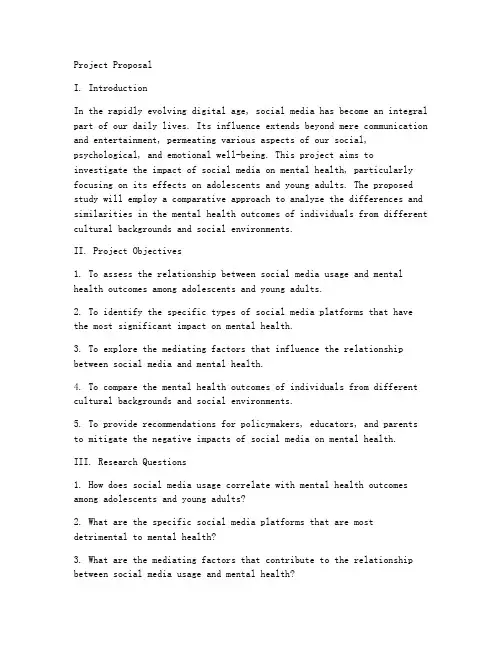
Project ProposalI. IntroductionIn the rapidly evolving digital age, social media has become an integral part of our daily lives. Its influence extends beyond mere communication and entertainment, permeating various aspects of our social, psychological, and emotional well-being. This project aims toinvestigate the impact of social media on mental health, particularly focusing on its effects on adolescents and young adults. The proposed study will employ a comparative approach to analyze the differences and similarities in the mental health outcomes of individuals from different cultural backgrounds and social environments.II. Project Objectives1. To assess the relationship between social media usage and mental health outcomes among adolescents and young adults.2. To identify the specific types of social media platforms that have the most significant impact on mental health.3. To explore the mediating factors that influence the relationship between social media and mental health.4. To compare the mental health outcomes of individuals from different cultural backgrounds and social environments.5. To provide recommendations for policymakers, educators, and parents to mitigate the negative impacts of social media on mental health.III. Research Questions1. How does social media usage correlate with mental health outcomes among adolescents and young adults?2. What are the specific social media platforms that are most detrimental to mental health?3. What are the mediating factors that contribute to the relationship between social media usage and mental health?4. Are there significant differences in mental health outcomes between individuals from different cultural backgrounds and social environments?5. What strategies can be implemented to promote healthier social media usage and improve mental health?IV. MethodologyThis project will employ a mixed-methods approach, combiningquantitative and qualitative research methods to gather comprehensive data. The following methodology will be used:1. Literature Review: An extensive review of existing literature on the impact of social media on mental health will be conducted to identify gaps in current research and to establish a theoretical framework for the proposed study.2. Quantitative Data Collection: A survey will be designed to collect data on social media usage patterns, mental health outcomes, and demographic information from a sample of adolescents and young adults. The survey will be distributed through various online platforms and social media channels to ensure a diverse and representative sample.3. Qualitative Data Collection: In-depth interviews will be conducted with a subset of the survey participants to gain insights into their personal experiences with social media and its impact on their mental health.4. Data Analysis: Quantitative data will be analyzed using statistical software (e.g., SPSS) to identify correlations and trends. Qualitative data will be analyzed using thematic analysis to identify common themes and patterns.V. Expected OutcomesThe proposed study is expected to yield several significant outcomes:1. A better understanding of the relationship between social media usage and mental health outcomes among adolescents and young adults.2. Identification of specific social media platforms that pose a greater risk to mental health.3. Insights into the mediating factors that influence the relationship between social media and mental health.4. Comparative analysis of mental health outcomes across different cultural backgrounds and social environments.5. Recommendations for policymakers, educators, and parents to promote healthier social media usage and improve mental health.VI. BudgetThe budget for this project is estimated to be $50,000, which will cover the following expenses:1. Survey design and distribution: $10,0002. Data analysis software: $5,0003. In-depth interviews: $10,0004. Research assistants: $10,0005. Contingency funds: $5,000VII. ConclusionThis project is designed to shed light on the complex relationship between social media usage and mental health. By exploring this relationship through a comparative lens, we aim to contribute valuable insights to the ongoing discussion on how to mitigate the negative impacts of。
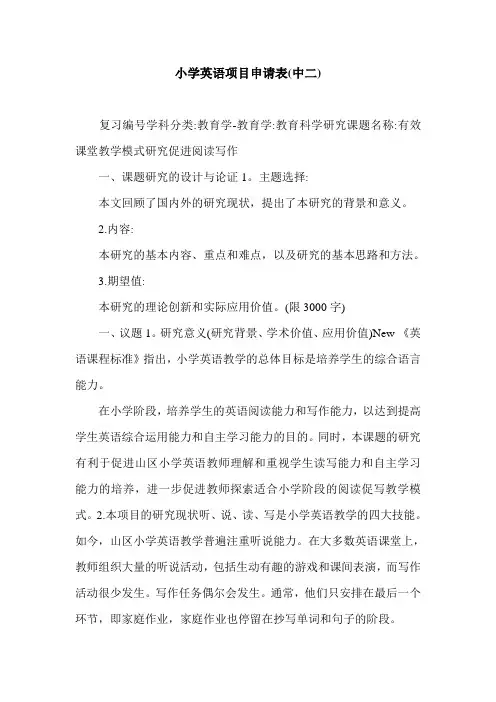
小学英语项目申请表(中二)复习编号学科分类:教育学-教育学:教育科学研究课题名称:有效课堂教学模式研究促进阅读写作一、课题研究的设计与论证1。
主题选择:本文回顾了国内外的研究现状,提出了本研究的背景和意义。
2.内容:本研究的基本内容、重点和难点,以及研究的基本思路和方法。
3.期望值:本研究的理论创新和实际应用价值。
(限3000字)一、议题1。
研究意义(研究背景、学术价值、应用价值)New 《英语课程标准》指出,小学英语教学的总体目标是培养学生的综合语言能力。
在小学阶段,培养学生的英语阅读能力和写作能力,以达到提高学生英语综合运用能力和自主学习能力的目的。
同时,本课题的研究有利于促进山区小学英语教师理解和重视学生读写能力和自主学习能力的培养,进一步促进教师探索适合小学阶段的阅读促写教学模式。
2.本项目的研究现状听、说、读、写是小学英语教学的四大技能。
如今,山区小学英语教学普遍注重听说能力。
在大多数英语课堂上,教师组织大量的听说活动,包括生动有趣的游戏和课间表演,而写作活动很少发生。
写作任务偶尔会发生。
通常,他们只安排在最后一个环节,即家庭作业,家庭作业也停留在抄写单词和句子的阶段。
一些教师担心课堂写作会占用更多的时间,影响教学进度,而另一些教师则认为“写作”不如听、说、做、唱等活动那么生动,“写作”会冲淡课堂教学原有的生动气氛,在一定程度上降低课堂的活力。
原因是:一是教师缺乏对学生系统写作知识的策略指导;其次,学生缺乏时间和空间去思考和消化他们所学的句子和单词。
第三,学生不会积累很多单词和句子。
这些原因导致了一个恶性循环,即学生一开始盲目写作,不愿意写,害怕写,最后拒绝写。
这也导致许多小学毕业生进入初中后读写基础薄弱。
二、研究的基本内容、重点和难点、研究目的的基本思路和方法:提高学生的读写能力和自主学习能力,促进探索小学英语教师通过阅读促进写作的有效课堂模式。
基本内容:1.通过多角度有意识的课堂阅读指导和训练,提高学生的阅读能力,使学生掌握一定的阅读策略。
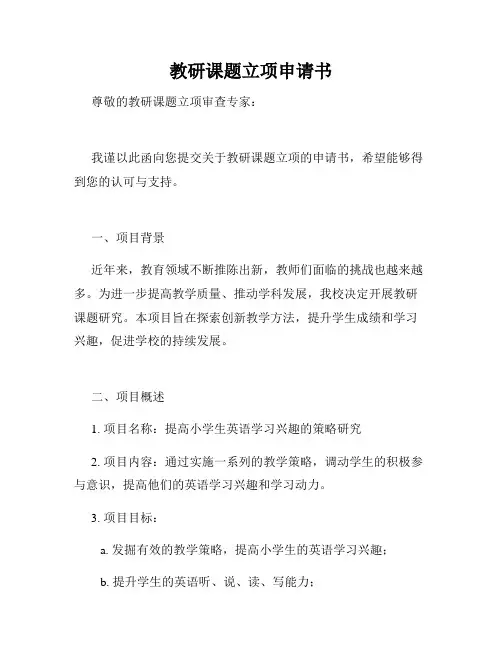
教研课题立项申请书尊敬的教研课题立项审查专家:我谨以此函向您提交关于教研课题立项的申请书,希望能够得到您的认可与支持。
一、项目背景近年来,教育领域不断推陈出新,教师们面临的挑战也越来越多。
为进一步提高教学质量、推动学科发展,我校决定开展教研课题研究。
本项目旨在探索创新教学方法,提升学生成绩和学习兴趣,促进学校的持续发展。
二、项目概述1. 项目名称:提高小学生英语学习兴趣的策略研究2. 项目内容:通过实施一系列的教学策略,调动学生的积极参与意识,提高他们的英语学习兴趣和学习动力。
3. 项目目标:a. 发掘有效的教学策略,提高小学生的英语学习兴趣;b. 提升学生的英语听、说、读、写能力;c. 培养学生的自主学习能力和团队合作意识;d. 提高学生在英语学科中的综合素养水平。
4. 项目执行:a. 项目实施周期:2022年9月至2023年6月;b. 项目实施地点:本校小学部;c. 项目参与人员:本校英语学科教师;d. 项目预算:本项目预期需要资金30,000元,用于购买教学资源、制作教学辅助工具和开展评估考核等。
三、项目进度安排1. 阶段一:项目策划与准备阶段(2022年9月-2022年10月)a. 成立项目组,制定详细的项目实施计划;b. 确定教学策略和方法,编制教学资源;c. 搜集相关文献和研究资料,进行理论研究和课题背景调研。
2. 阶段二:教学实施与数据收集阶段(2022年11月-2023年4月)a. 开展英语教学活动,实施各项教学策略;b. 收集学生学习数据和问题反馈;c. 定期组织教研讨论和经验交流。
3. 阶段三:评估分析与成果总结阶段(2023年5月-2023年6月)a. 对项目实施效果进行评估分析;b. 撰写课题研究报告,总结成果和经验;c. 开展研讨会,与其他学校和专家进行交流。
四、项目预期成果1. 改进教学策略:通过实施本课题研究,预计能够提供一些创新的教学策略和方法,供其他学校和教师参考和借鉴。
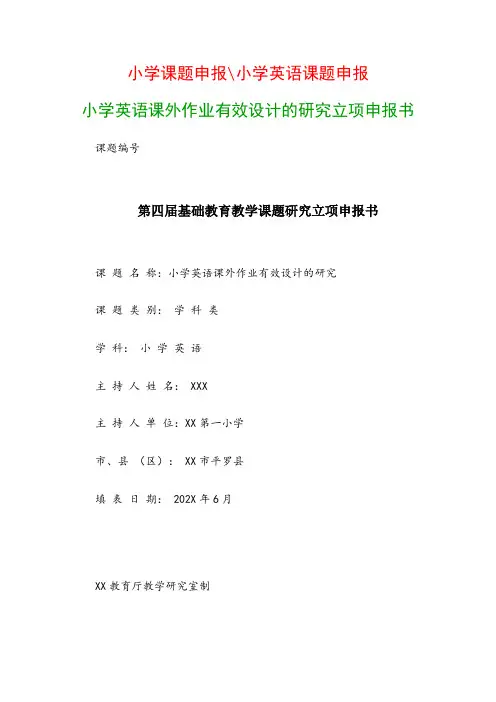
小学课题申报\小学英语课题申报小学英语课外作业有效设计的研究立项申报书课题编号第四届基础教育教学课题研究立项申报书课题名称:小学英语课外作业有效设计的研究课题类别:学科类学科:小学英语主持人姓名: XXX主持人单位:XX第一小学市、县(区): XX市平罗县填表日期: 202X年6月XX教育厅教学研究室制填表说明1.本表可在自治区教研室网站“课题研究—课题研究公告”栏目下载。
2.填写内容统一字体为:楷体,字号为小四。
使用A4纸正反面打印,左侧装订,封面不得使用塑料封皮,上报时一式三份装在牛皮档案袋内。
3.封面除“课题编号”“是否立项”不填外,其他不得有空白项:课题名称:应准确、简明反应研究内容,最多不超过26个汉字(包括标点符号);课题类别:根据《宁夏第四届基础教育教学课题研究方向参考指南》填写以下其中一项:综合类、信息化教学资源有效应用类、学科类、学前教育类;学科:根据国家课程方案中设置的学科类别准确填写,不属于任何一类学科的请填写“其它”;课题组核心成员基本情况(≤10人):此项不包含主持人基本情况。
4.课题申报人所在单位要对其申报资格和研究条件进行认真审核,签署书面意见并盖章。
填写内容要实事求是,文字表述清楚,简明扼要,严格按照要求填写,不得更改表格内容和格式。
5.各市教研室将《宁夏第四届基础教育教学课题研究立项申报书》纸质版(一式三份)和电子版打包报送自治区教研室。
申报书电子版命名为市县(区)+主持人姓名+课题名称。
6.所有上交材料不退,请自行备份。
课题名称小学英语课外作业有效设计的研究课题类别学科类学科小学英语一、课题主持人基本情况主持人姓名 XXX 性别男参加工作时间 202X年级英语作业写的少,学生学英语的兴趣浓厚,但是到了高年级,随着写的作业增多,许多同学开始不适应,成绩也下降很快。
所以小学英语课外作业有效设计的研究迫在眉睫。
小学英语课外作业作为课堂教学的延伸和补充,课外作业是课堂教学的重要环节。
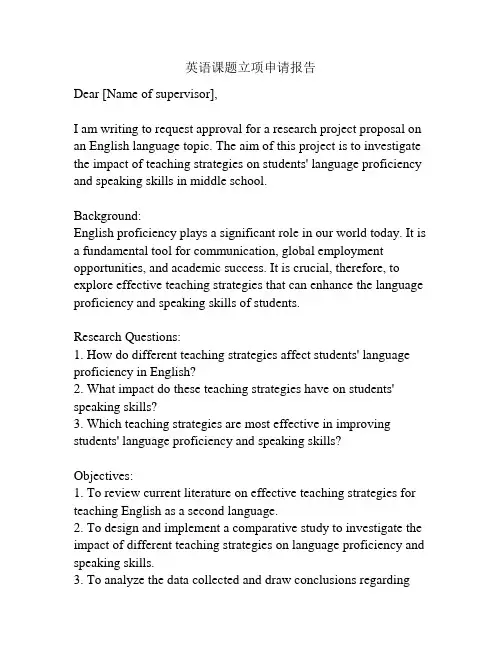
英语课题立项申请报告Dear [Name of supervisor],I am writing to request approval for a research project proposal on an English language topic. The aim of this project is to investigate the impact of teaching strategies on students' language proficiency and speaking skills in middle school.Background:English proficiency plays a significant role in our world today. It is a fundamental tool for communication, global employment opportunities, and academic success. It is crucial, therefore, to explore effective teaching strategies that can enhance the language proficiency and speaking skills of students.Research Questions:1. How do different teaching strategies affect students' language proficiency in English?2. What impact do these teaching strategies have on students' speaking skills?3. Which teaching strategies are most effective in improving students' language proficiency and speaking skills? Objectives:1. To review current literature on effective teaching strategies for teaching English as a second language.2. To design and implement a comparative study to investigate the impact of different teaching strategies on language proficiency and speaking skills.3. To analyze the data collected and draw conclusions regardingthe most effective teaching strategies for improving language proficiency and speaking skills.Methodology:1. Literature Review: Conduct a comprehensive review of existing research papers, articles, and books related to teaching strategies in English language education.2. Data Collection: Select a sample of middle school students and divide them into groups. Each group will be taught using a different teaching strategy, such as direct instruction, cooperative learning, or task-based learning. Assessments such as standardized tests and speaking tasks will be used to measure language proficiency and speaking skills before and after the intervention.3. Data Analysis: Analyze the collected data using statistical methods to determine the impact of each teaching strategy on students' language proficiency and speaking skills.4. Conclusion: Summarize the findings and draw conclusions regarding the most effective teaching strategies for improving language proficiency and speaking skills.Anticipated Outcomes:By the completion of this project, it is anticipated that we will gain a deeper understanding of the effectiveness of various teaching strategies in enhancing students' language proficiency and speaking skills. This research will contribute to the existing literature on language education and provide guidance to educators in selecting appropriate teaching strategies.Timeline:- Literature Review: 2 months- Data Collection: 3 months- Data Analysis: 1 month- Report Writing: 1 monthBudget:The anticipated budget for this research project includes expenses related to data collection and analysis, participant incentives, and research materials. A detailed budget proposal will be submitted upon approval of the project.I believe that this research project will bring valuable insights and contribute to the improvement of English language education in middle schools. I kindly request your approval and support to proceed with this proposed project.Thank you for considering my application. I am available for further discussion or clarification if needed.Sincerely,[Your Name]。
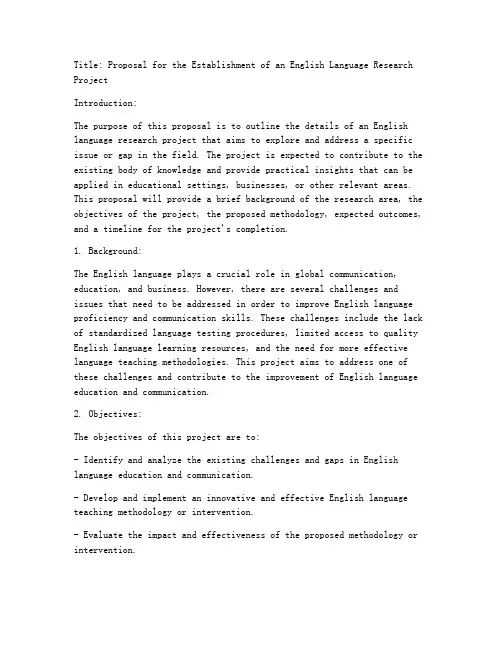
Title: Proposal for the Establishment of an English Language Research ProjectIntroduction:The purpose of this proposal is to outline the details of an English language research project that aims to explore and address a specific issue or gap in the field. The project is expected to contribute to the existing body of knowledge and provide practical insights that can be applied in educational settings, businesses, or other relevant areas. This proposal will provide a brief background of the research area, the objectives of the project, the proposed methodology, expected outcomes, and a timeline for the project's completion.1. Background:The English language plays a crucial role in global communication, education, and business. However, there are several challenges and issues that need to be addressed in order to improve English language proficiency and communication skills. These challenges include the lack of standardized language testing procedures, limited access to quality English language learning resources, and the need for more effective language teaching methodologies. This project aims to address one of these challenges and contribute to the improvement of English language education and communication.2. Objectives:The objectives of this project are to:- Identify and analyze the existing challenges and gaps in English language education and communication.- Develop and implement an innovative and effective English language teaching methodology or intervention.- Evaluate the impact and effectiveness of the proposed methodology or intervention.- Disseminate the findings of the project to relevant stakeholders and contribute to the existing body of knowledge.3. Proposed Methodology:The proposed methodology for this project will involve several steps, including:- Conducting a thorough literature review to identify the existing challenges and gaps in English language education and communication.- Developing and implementing an innovative and effective English language teaching methodology or intervention, based on the findings of the literature review.- Conducting empirical research to evaluate the impact and effectiveness of the proposed methodology or intervention.- Analyzing and interpreting the data collected during the research phase.- Disseminating the findings of the project through research papers, presentations, or other relevant means.4. Expected Outcomes:The expected outcomes of this project include:- A comprehensive understanding of the existing challenges and gaps in English language education and communication.- The development and implementation of an innovative and effective English language teaching methodology or intervention.- Empirical evidence on the impact and effectiveness of the proposed methodology or intervention.- A contribution to the existing body of knowledge in the field of English language education and communication.- Enhanced English language proficiency and communication skills among the target population.5. Timeline:The proposed timeline for the completion of this project is as follows:- Month 1-3: Conducting a thorough literature review and identifying the existing challenges and gaps in English language education and communication.- Month 4-6: Developing and implementing an innovative and effective English language teaching methodology or intervention.- Month 7-9: Conducting empirical research to evaluate the impact and effectiveness of the proposed methodology or intervention.- Month 10-12: Analyzing and interpreting the data collected during the research phase, and preparing research papers or presentations for dissemination.Conclusion:In conclusion, this project aims to contribute to the improvement of English language education and communication by addressing a specific challenge or gap in the field. The proposed methodology and timelinewill ensure the effective implementation and evaluation of the project, leading to meaningful outcomes that can be disseminated to relevant stakeholders. The successful completion of this project will provide valuable insights and practical solutions that can be applied in educational settings, businesses, or other relevant areas.。
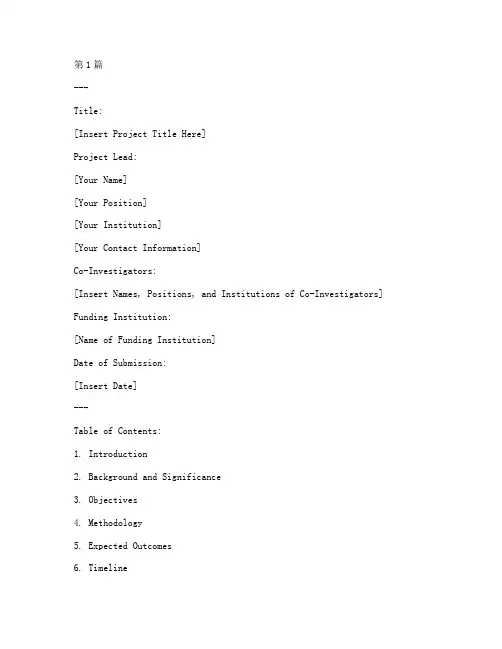
第1篇---Title:[Insert Project Title Here]Project Lead:[Your Name][Your Position][Your Institution][Your Contact Information]Co-Investigators:[Insert Names, Positions, and Institutions of Co-Investigators] Funding Institution:[Name of Funding Institution]Date of Submission:[Insert Date]---Table of Contents:1. Introduction2. Background and Significance3. Objectives4. Methodology5. Expected Outcomes6. Timeline7. Budget8. Risks and Mitigation Strategies9. Ethical Considerations10. Dissemination Plan11. References---1. IntroductionThis document presents a detailed proposal for a research project titled [Insert Project Title Here]. The project is designed to [briefly describe the purpose of the project]. The proposed research aims to address [briefly describe the research problem or gap]. The project is significant because [briefly explain the importance of the research].---2. Background and Significance2.1 Background:[Provide a comprehensive background of the research area, including historical context, current trends, and key contributions of previous studies.]2.2 Significance:[Explain the importance of the research in terms of its potential impact on theory, practice, and policy. Discuss how the findings could contribute to the field of English language studies.]---3. ObjectivesThe primary objectives of this research project are as follows:1. [Objective 1: Briefly describe the first objective of the project.]2. [Objective 2: Briefly describe the second objective of the project.]3. [Objective 3: Briefly describe the third objective of the project.]---4. Methodology4.1 Research Design:[Describe the overall research design, such as quantitative, qualitative, or mixed-methods approach.]4.2 Data Collection:[Explain the methods for collecting data, including sampling techniques, instruments, and procedures.]4.3 Data Analysis:[Describe the analytical techniques that will be used to analyze the data, such as statistical analysis, thematic analysis, or content analysis.]4.4 Ethical Considerations:[Discuss the ethical considerations involved in the research, such as informed consent, confidentiality, and data protection.]---5. Expected OutcomesThe expected outcomes of this research project include:1. [Outcome 1: Briefly describe the first expected outcome.]2. [Outcome 2: Briefly describe the second expected outcome.]3. [Outcome 3: Briefly describe the third expected outcome.]These outcomes are expected to contribute to the advancement of knowledge in the field of English language studies and have practicalimplications for [briefly mention the potential applications or beneficiaries].---6. TimelineThe project is expected to be completed within [insert time frame, e.g., 24 months]. The timeline is as follows:Year 1:- [Month 1-3]: Literature review and theoretical framework development- [Month 4-6]: Data collection- [Month 7-9]: Data analysis- [Month 10-12]: Drafting of initial findings and project progressreportYear 2:- [Month 1-3]: Final data analysis and refinement of findings- [Month 4-6]: Writing of final report and dissemination of findings- [Month 7-9]: Submission of manuscript(s) for publication- [Month 10-12]: Project evaluation and follow-up activities---7. BudgetThe total budget for this research project is [insert total budget amount]. The budget breakdown is as follows:- Personnel Costs: [Insert details of personnel costs, including salaries, honoraria, and travel expenses.]- Equipment and Materials: [Insert details of equipment and materials required for the project.]- Research Expenses: [Insert details of research expenses, including data collection and analysis tools.]- Dissemination and Outreach: [Insert details of dissemination and outreach activities, such as conferences, workshops, and publications.]- Contingency Fund: [Insert a contingency fund for unforeseen expenses.]---8. Risks and Mitigation Strategies8.1 Risks:- [List potential risks that could impact the project, such as delays in data collection, technical issues, or loss of funding.]8.2 Mitigation Strategies:- [Describe strategies to mitigate each identified risk, such as backup plans for data collection, technical support, and contingency funding.]---9. Ethical ConsiderationsThis research project will adhere to the ethical guidelines set forth by [insert relevant ethical board or institution]. The following ethical considerations will be addressed:- Informed consent: Participants will be informed about the purpose, procedures, and potential risks of the study, and will provide written consent before participating.- Confidentiality: Participant data will be kept confidential and will be stored securely.- Data protection: Data will be anonymized and de-identified to ensure privacy.---10. Dissemination PlanThe findings of this research project will be disseminated through the following channels:- [List academic journals, conferences, and workshops where the research findings will be presented.]- [Describe any potential collaborations with educational institutions, professional organizations, or government agencies to disseminate the findings.]- [Discuss the possibility of publishing a book or monograph based on the research.]- [Explain the use of social media, blogs, and other online platforms to share the research with a broader audience.]---11. References[Provide a list of all references cited in the proposal.]---ConclusionThis proposal outlines a comprehensive research project that aims to contribute to the field of English language studies. The project iswell-justified in terms of its significance, objectives, methodology, and potential outcomes. We are confident that the proposed research will yield valuable insights and have a lasting impact on the field.We kindly request your consideration of this proposal and look forward to the opportunity to discuss it further.Sincerely,[Your Name][Your Position][Your Institution]---Please note that this template is a general outline and should be customized to fit the specific requirements of the funding institution and the project details.第2篇Project Proposal Form1. Project Title:[Insert Project Title Here]2. Applicant Information:- Name: [Your Full Name]- Institution: [Your Institution]- Department: [Your Department]- Position: [Your Position]- Contact Information:- Email: [Your Email Address]- Phone: [Your Phone Number]3. Project Summary:In this section, provide a brief overview of the project, its objectives, and the expected outcomes.[Insert Project Summary Here. This should be a concise paragraphoutlining the project's purpose, the problem it addresses, and the key objectives.]4. Background and Rationale:This section should include a detailed explanation of the background,the rationale for the project, and the need for the proposed project.4.1 Background:[Provide a detailed background of the issue or problem that the project aims to address. Include historical context, current trends, and any relevant data or statistics.]4.2 Rationale:[Explain why the project is necessary. Discuss the impact of the problem on the target audience, the educational system, or the broader community. Highlight the significance of the project in terms of innovation, improvement, or addressing an unmet need.]5. Objectives and Goals:Clearly define the objectives and goals of the project. These should be specific, measurable, achievable, relevant, and time-bound (SMART).5.1 Objectives:- [Objective 1]- [Objective 2]- [Objective 3]5.2 Goals:- [Goal 1]- [Goal 2]- [Goal 3]6. Project Activities:Provide a detailed description of the activities that will be carriedout to achieve the objectives and goals of the project.6.1 Activity 1:- Description: [Detailed description of Activity 1]- Duration: [Expected duration of Activity 1]- Resources Required: [List of resources required for Activity 1]6.2 Activity 2:- Description: [Detailed description of Activity 2]- Duration: [Expected duration of Activity 2]- Resources Required: [List of resources required for Activity 2][Continue listing additional activities as necessary.]7. Methodology:Explain the methodology that will be used to implement the project. This should include the research approach, data collection methods, and analysis techniques.7.1 Research Approach:[Describe the overall research approach, such as qualitative, quantitative, or mixed methods.]7.2 Data Collection Methods:- [Method 1]- [Method 2]- [Method 3]7.3 Data Analysis Techniques:[Outline the techniques that will be used to analyze the collected data.]8. Project Timeline:Present a timeline that outlines the key milestones and deadlines for the project. Use a Gantt chart or a table to visualize the timeline.9. Budget:Provide a detailed budget that includes all anticipated expenses. Break down the budget into categories such as personnel, materials, travel, and equipment.9.1 Personnel Costs:- [Personnel 1]- [Personnel 2]- [Personnel 3]9.2 Materials Costs:- [Material 1]- [Material 2]- [Material 3]9.3 Travel Costs:- [Travel Expense 1]- [Travel Expense 2]- [Travel Expense 3]9.4 Equipment Costs:- [Equipment 1]- [Equipment 2]- [Equipment 3][Total Budget: [Insert Total Budget Here]]10. Evaluation Plan:Describe the criteria and methods that will be used to evaluate the project's success and impact.10.1 Evaluation Criteria:- [Criteria 1]- [Criteria 2]- [Criteria 3]10.2 Evaluation Methods:- [Method 1]- [Method 2]- [Method 3]11. Dissemination Plan:Outline how the project's findings and outcomes will be shared with stakeholders, including the intended audience, dissemination channels, and timelines.11.1 Audience:- [Target Audience 1]- [Target Audience 2]- [Target Audience 3]11.2 Dissemination Channels:- [Channel 1]- [Channel 2]- [Channel 3]11.3 Timelines:- [Timeline 1]- [Timeline 2]- [Timeline 3]12. Conclusion:Summarize the project's objectives, the proposed activities, and the expected outcomes. Emphasize the project's significance and thepotential impact on the field of English language teaching.13. References:List all references cited in the proposal.14. Appendices:Include any additional materials that support the proposal, such as surveys, questionnaires, or previous research findings.---Note: This template is a guide and should be customized according to the specific requirements of the funding agency or institution. Ensure that all sections are fully developed and supported by evidence, and that the project proposal is clear, concise, and compelling.第3篇---Title of the Research Project:[Insert the title of your research project here]Researcher’s Name:[Insert your full name]Institutional Affiliation:[Insert your institution’s name]Department/Division:[Insert your department or division’s name]Date of Submission:[Insert the date of submission]---Table of Contents1. Introduction2. Background and Significance of the Project3. Research Objectives and Hypotheses4. Literature Review5. Methodology6. Expected Outcomes and Impact7. Time Schedule8. Budget and Resources9. References---1. IntroductionThe following proposal outlines the research project titled [Insert the title of your research project here]. This project aims to [briefly state the main objective of the research]. The research is significant as it addresses [briefly describe the problem or gap in knowledge that the research will address]. The proposed research will contribute to the field of [insert relevant field] by [briefly describe the expected contribution].---2. Background and Significance of the Project2.1 Background:[Provide a comprehensive background on the topic, including historical context, current trends, and any relevant theories or concepts. Explain how the research project fits into this broader context.]2.2 Significance:[Discuss the importance of the research. Explain how the findings will contribute to the field, address a practical problem, or fill a gap in the literature. Consider the potential benefits to academia, industry, or society.]---3. Research Objectives and Hypotheses3.1 Research Objectives:- Objective 1: [State the first objective of the research, which should be specific, measurable, achievable, relevant, and time-bound (SMART).]- Objective 2: [State the second objective.]- Objective 3: [State the third objective.]3.2 Hypotheses:- Hypothesis 1: [State the first hypothesis, which should be testable and based on the research objectives.]- Hypothesis 2: [State the second hypothesis.]- Hypothesis 3: [State the third hypothesis.]---4. Literature ReviewThis section should provide a critical analysis of existing literature related to the research topic. It should include:- A summary of key theories, models, and concepts.- An overview of previous research studies and their findings.- Identification of gaps or limitations in the existing literature that the proposed research will address.---5. Methodology5.1 Research Design:[Describe the overall research design, such as qualitative, quantitative, mixed methods, or case study.]5.2 Data Collection Methods:[Detail the methods for collecting data, including surveys, interviews, experiments, observations, or secondary data analysis.]5.3 Data Analysis Techniques:[Explain the statistical or qualitative analysis techniques that will be used to analyze the data.]5.4 Ethical Considerations:[Discuss any ethical considerations relevant to the research, such as informed consent, participant confidentiality, and data security.]---6. Expected Outcomes and Impact6.1 Expected Outcomes:- Outcome 1: [Describe the first expected outcome of the research.]- Outcome 2: [Describe the second expected outcome.]- Outcome 3: [Describe the third expected outcome.]6.2 Impact:[Discuss the potential impact of the research on the field, industry, or society. Consider the long-term implications and potential for future research.]---7. Time Schedule[Provide a detailed timeline for the project, including key milestones, such as literature review completion, data collection, data analysis, and final report submission.]---8. Budget and Resources8.1 Budget:[Provide a detailed budget for the research project, including costs for personnel, materials, equipment, travel, and other expenses.]8.2 Resources:[Identify the resources required for the research, such as access to libraries, databases, equipment, and personnel.]---9. References[Include a comprehensive list of all references cited in the proposal, formatted according to the relevant citation style.]---ConclusionThis research project proposal outlines a comprehensive plan for investigating [insert the research topic]. The proposed research aims to address a significant gap in the field and has the potential to contribute to the knowledge base and practical applications in [insert relevant field]. With a clear methodology, realistic timeline, and well-defined budget, this project is poised to yield valuable insights and outcomes.---[Your Name][Your Contact Information][Institutional Affiliation]---Note: This template is a guide and should be customized to fit the specific requirements of the funding agency or institution. Ensure that the content is thorough, concise, and meets all the necessary criteria for the application process.。
培养小学生英语阅读能力的课题申请《培养小学生英语阅读能力的课题申请》一、立项依据英语教育在中国的普及和推广已经取得显著成效,然而小学生英语阅读能力相对较弱,不仅束缚了他们的学习兴趣和表达能力的发展,也影响了他们未来的学习和职业发展。
因此,本课题旨在通过系统的英语阅读教育方法和策略,提高小学生英语阅读能力。
二、课题意义1. 实现教育目标:小学阶段是培养学生基本的学习和思维能力的关键时期,而英语作为国际交流的重要工具,培养小学生的英语阅读能力,有助于帮助他们更好地应对未来的学习和事业挑战。
2. 提高综合能力:英语阅读是对听、说、读、写四个技能的综合运用,通过提高小学生的阅读能力,有助于提高他们在听、说、读、写各方面的英语综合能力。
3. 拓展视野:通过阅读英语原版图书、报纸、杂志和网站等,可以帮助小学生拓宽视野,了解国际社会的潮流和发展动态,促进跨文化交流和理解。
4. 提高表达能力:英语阅读能力的提高,将有助于小学生提高他们的表达能力,使他们能够更自信地进行口语表达和写作。
三、研究内容及目标1. 研究内容(1)小学英语阅读教育的现状分析:通过对目前小学英语阅读教育的问题和挑战进行深入了解和研究,为制定切实可行的阅读教育策略提供依据。
(2)小学英语阅读教育的原则和方法:总结和归纳成功的英语阅读教育经验,探讨适合小学生的英语阅读教育原则和方法。
(3)小学英语阅读教材的开发与评价:根据小学生的学习特点和英语阅读能力需求,开发适合小学生的英语阅读教材,并进行评估和反馈。
(4)小学英语阅读教育的课程设计:设计小学英语阅读教育的有效课程,包括教学目标、教学内容、教学方法和教学评价等。
2. 研究目标(1)提高小学生的英语阅读能力,包括词汇量、阅读理解和阅读速度等方面。
(2)培养小学生的阅读兴趣和阅读习惯,促进他们对英语阅读的主动参与。
(3)推广和分享成功的英语阅读教育经验,为其他学校和教师提供参考。
四、研究方法与步骤1. 研究方法(1)文献综述:对相关文献、报刊、论文进行综合分析和研究,了解国内外小学英语阅读教育的发展状况和成果。
小学英语课题申报立项书范文As a document creator, I am now playing the role of a primary school English lesson project proposer. Below is the sample text for the English project proposal:Introduction:English education is an essential part of primary school curriculum, as it helps students develop language skills, communication abilities, and cultural awareness. In order to enhance the quality of English teaching and learning in our school, I propose a new English lesson project that aims to engage students in interactive and immersive language activities.Project Objectives:1. To improve students' English language proficiency through fun and engaging activities.2. To enhance students' communication skills by providing opportunities for speaking and listening practice.3. To foster students' interest in English language and culture through interactive lessons and games.4. To create a supportive and inclusive learning environment where all students feel motivated and encouraged to participate.Project Activities:1. Interactive Language Games: Incorporate language games such as word puzzles, charades, and role-playing activities to make learning English fun and engaging.2. Storytelling Sessions: Encourage students to share their own stories or read English storybooks aloud to practice speaking and listening skills.3. Cultural Exchange Activities: Organize cultural exchange events where students can learn about different English-speaking countries and their traditions.4. Language Workshops: Invite guest speakers or language experts to conduct workshops on specific language topics or skills.Project Implementation:The project will be implemented in collaboration with English teachers, school administrators, and parent volunteers. Regular meetings will be held to discuss lesson plans, assess student progress, and address any challenges that may arise. Feedback from students, teachers, and parents will be collected to evaluate the effectiveness of the project and make necessary adjustments.Project Evaluation:At the end of the project, a comprehensive evaluation will be conducted to assess the impact of the new English lesson project on students' language proficiency, communication skills, and overall interest in learning English. Results will be shared with school stakeholders to inform future English teaching strategies and initiatives.Conclusion:In conclusion, the proposed English lesson project aims to create a dynamic and engaging learning environment for students to improve their English language skills and cultural awareness. By implementing interactive activities, fostering communication skills, and promoting a love for the English language, we hope to inspire students to become lifelong learners and global citizens. Thank you for considering this project proposal.。
附件二大北汪总校小课题研究申报表一、基本情况三、预期成果四、课题所在单位意见五、总校规划办评审意见英语小课题调查报告白彦其我校学生来自两个村学生合并在一起,,有的在小学一年级时就开始学习英语,各学校教学特色,教学侧重点,教学水平各异。
心理发展水平也有较大区别.种种原因使学生在英语基础知识、技能方面存在着很大的个体差异。
导致英语学习状态不容乐观。
很多学生对英语不感兴趣,为了找到最合适的教学方式方法,提高英语教学质量,对学生英语学科的特点进行调查研究。
一、调查概况1、主要内容:学生学习习惯、学习态度、学习英语的途径、对英语的认识等。
2、调查范围:所任教班级抽样调查15人.3、调查方法:以问卷调查为主,兼有访谈法、观察法.4、调查过程:(1)依内容及学生具体情况确定问卷的题目.(2)对学生进行抽样调查(3)收回问卷对情况总结归纳.二、分析;1.英语习得途径单一,使用范围窄.调查数据确表明,只有31%的学生能进行课外阅读,获取与英语有关的知识。
英语是一门学科,更是一种语言。
课后大部分学很少有读英语的习惯,能在日常生活中应用所说学英语知识的机会更是少之又少。
单一的习得途径,狭窄的适用范围,使学生在英语听、说、读、写法四项技能方面的不到充分的发挥。
2.未养成良好的学习习惯调查表明,学生学习英语缺乏良好的学习习惯,25%的学生制定计划但未实施,有31%的学生不订计划,盲目学习.有70%人仅仅是偶然进行课前的预习和课后的复习.有的学生养成了预习习惯,能主动思考,努力理解,消化一些问题,能带不懂的问题有准备地进入课堂.3.学生英语学习能力有进一步提高的空间各班的学困生较多这就要求我们多方入手。
从端正学习态度,授予正确的学习方法,提高教学质量、学习兴趣入手.小学英语课提高学生开口面开题报告一、课题的目的与意义在应试教育的指挥棒下,英语课堂教学还如从前一样—-单调、枯燥、繁琐与压抑,学生英语素养却没有得到真正有效的提高。